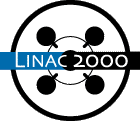
S. D. NELSON (LLNL)*, M. VELLA (LBL)
Electron beams of linear induction accelerators experience deflective forces caused by RF fields building up as a result of accelerating cavities of finite size. These forces can significantly effect the beam when a long linac composed of identical cells is assembled. Recent techniques in computational modeling, simulation, and experiments for 20 MeV DARHT-II accelerator cells were found to reduce the wakefield impedance of the cells from 800 ohms/meter to 350 ohms/meter and experimental results confirm the results of the modeling efforts. Increased performance of the cell was obtained through a parametric study of the accelerator structure, materials, material tuning, and geometry. As a result of this effort, it was found that thickness-tuned ferrite caused a 50% deduction in the wakefield impedance in the low frequency band and was easily tunable based on the material thickness. It was also found that shaped metal sections allow for high Q resonances to be de-tuned, thus decreasing the amplitude of the resonance and increasing the cell's performance. For the geometries used for this cell, a roughly 45 degree angle had the best performance in affecting the wakefield modes.
* This work was performed under the auspices of the U.S. Department of Energy by the University of California Lawrence Livermore National Laboratory under contract No. W-7405-Eng-48.
Comments or Questions to
linac2000@slac.stanford.edu